Skywatchers from Alaska to Eastern Europe were treated to a total lunar eclipse on Saturday night, when the Moon dipped behind the Earth’s shadow. Chunks of the Moon began to disappear at 2332 Universal Time (6:32 pm EST), and then it turned a coppery red about two hours later. And then four hours after it started, the eclipse was over. Many observers said it was one of the brightest eclipses they’d seen in recent years. If you missed this show, don’t worry, there are two more lunar eclipses coming in 2004. Then a break; there won’t be another total lunar eclipse visible until 2007.
ESA Cancels Eddington
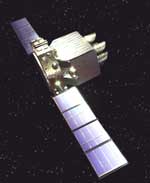
Image credit: ESA
The European Space Agency announced this week that it has canceled Eddington, a space-based observatory designed to search for extrasolar planets. They’re also going to be scaling back the BepiColombo mission to Mercury by removing the lander that was supposed to accompany the spacecraft. The agency blamed the cuts on budget overruns with other missions, such as Rosetta. One new mission was announced, however. The LISA Pathfinder will serve as a prototype to help search for gravity waves.
Today, at its 105th meeting, ESA’s Science Programme Committee (SPC) has made important decisions concerning the Cosmic Vision programme. Due to the current financial exigencies and an outlook with no budget increase or other relief, the SPC was forced to cancel the Eddington mission and rescope the BepiColombo mission.
Eddington had two aims, both remarkable and very pertinent to front-line astronomical interests. The first aim was to look for Earth-like planets outside our solar system – one of the key goals in the search to understand how life came to be, how we came to live where we do in the universe and whether there are other potential life supporting environments ‘out there’. At the same time it was going to follow on the path blazed by the ESA-NASA mission SOHO had taken with the Sun of using astroseismology to look ‘inside’ stars. In the longer term, the loss of this one mission will not stop us pursuing the grand quests for which it is a step.
The loss of the BepiColombo lander is also scientifically hard to take. ESA, in conjunction with the Japanese space agency, JAXA, will still put two orbiters around Mercury but the ?ground truth? provided by the lander is a big loss. However, to land on a planet so near the Sun is no small matter and was a bridge too far in present circumstances, and this chance for Europe to be first has probably been lost.
The origins of the problems were recognized at the ESA Council, held in June 2003. Several sudden demands on finance occurred in the spring, the most obvious and public being the unforeseen Ariane 5 grounding in January. A loan of 100 million Euro was temporarily granted, that must be paid back out of present resources by the end of 2006.
ESA’s SPC were therefore caught in a vice. Immediate mission starts had to be severely limited and the overall envelope of the programme kept down.
By making today’s decision, the SPC has brought down the scope of the Cosmic Vision programme to a level that necessarily reflects the financial conditions rather than the ambitions of the scientific community.
A long and painful discussion during the SPC meeting resulted in the conclusion that only one new mission can be started at this time, namely LISA Pathfinder. The mission is the technical precursor to the world?s first gravitational wave astronomical observatory, LISA. The LISA mission itself (to be made in cooperation with the United States) is scheduled for launch in 2012.
ESA’s Cosmic Vision, set to last until 2012, is a living programme. It has to be able to constantly adapt to to the available funding as well as respond to the expectations of the scientific community, to technological developments. Within these boundaries, the decisions made by the SPC try to maximize the outcome of Cosmic Vision across disciplines, keeping it at the same time challenging and affordable. Nonetheless, there are many European scientists with ambitions that exceed the programme?s ability to respond.
Original Source: ESA News Release
NASA Selects Five Potential New Missions
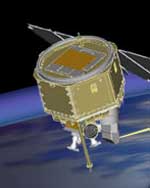
Image credit: NASA
NASA has selected five proposals as part of its Small Explorer (SMEX) missions – these are low-cost, highly specialized missions to help advance science in a specific area. The candidates are: the Normal-incidence Extreme Ultraviolet Spectrometer, the Dark Universe Observatory, the Interstellar Boundary Explorer, the Nuclear Spectroscopic Telescope Array, and the Jupiter Magnetospheric Explorer. Two finalists will eventually be chosen for launch by 2007-2008.
NASA recently selected candidate mission proposals that would study the universe, from Jupiter and the sun to black holes and dark matter. The proposals are candidates for missions in NASA’s Explorer Program of lower cost, highly focused, rapid-development scientific spacecraft.
Following detailed mission concept studies, NASA intends to select two of the mission proposals by fall 2004 for full development as Small Explorer (SMEX) missions. The two missions developed for flight will be launched in 2007 and 2008.
NASA has also decided to fund as a “Mission of Opportunity” a balloon-borne experiment to detect high-energy neutrinos, ghostly particles that fill the universe.
“The Small Explorer mission proposals we received show that the scientific community has a lot of innovative ideas on ways to study some of the most vexing questions in science, and to do it on a relatively small budget,” said Dr. Ed Weiler, associate administrator for space science at NASA Headquarters, Washington. “It was difficult to select only a few from among the many great proposals we received, but I think the selected proposals have a great chance to really push back the frontiers of knowledge,” he said.
The selected proposals were judged to have the best science value among 36 submitted to NASA in February 2003. Each will receive $450,000 ($250,000 for the Mission of Opportunity) to conduct a five-month implementation feasibility study. The selected SMEX proposals are:
- The Normal-incidence Extreme Ultraviolet Spectrometer (NEXUS): a solar spectrometer with major advances in sensitivity and resolution to reveal the cause of coronal heating and solar wind acceleration. Joseph M. Davila of NASA’s Goddard Space Flight Center (GSFC), Greenbelt, Md., would lead NEXUS at a total mission cost to NASA of $131 million.
- The Dark Universe Observatory (DUO): seven X-ray telescopes to measure the dark matter and dark energy that dominate the content of the universe with 100 times the sensitivity of previous X-ray studies. Richard E. Griffiths of Carnegie Mellon University, Pittsburgh, would lead DUO at a total mission cost to NASA of $132 million.
- The Interstellar Boundary Explorer (IBEX): a pair of cameras to image the boundary between the solar system and interstellar space with 100 times the sensitivity of previous experiments. David J. McComas of the Southwest Research Institute, San Antonio, would lead IBEX at a total mission cost to NASA of $132 million.
- The Nuclear Spectroscopic Telescope Array (NuSTAR): a telescope to carry out a census of black holes with 1000 times more sensitivity than previous experiments. NuSTAR would be lead by Fiona Anne Harrison of the California Institute of Technology, Pasadena, at a total mission cost to NASA of $132 million.
- The Jupiter Magnetospheric Explorer (JMEX): a telescope to study Jupiter’s aurora and magnetosphere from Earth orbit. Nicholas M. Schneider of the University of Colorado at Boulder would lead JMEX, at a total mission cost to NASA of $133 million.
NASA selected a long-duration balloon payload as the mission of opportunity. The Antarctic Impulsive Transient Antenna (ANITA) would detect radio waves emitted when high-energy neutrinos interact in the Antarctic ice shelf. ANITA would be led by Peter W. Gorham of the University of Hawaii at Manoa in Honolulu, at a total mission cost to NASA of $35 million.
In addition, NASA selected a proposed mission for technology-development funding of the proposed instrument. Jean Swank of GSFC will develop a polarization sensitive X-ray detector. Swank will receive up to $300,000 over the next two years for her study.
The five selected SMEX proposals are vying to be the tenth and eleventh SMEX missions selected for full development. Recent selections include the Reuven Ramaty High Energy Solar Spectroscopic Imager (RHESSI), launched in February 2002; the Galaxy Evolution Explorer (GALEX), launched in April 2003; and the Aeronomy of Ice in the Mesosphere mission (AIM), to be launched in 2006. The Explorer Program, managed by GSFC for NASA’s Office of Space Science, is designed to provide frequent, low-cost access to space for physics and astronomy missions with small to mid-sized spacecraft.
Original Source: NASA News Release
Construction on Alma Radio Telescope Begins
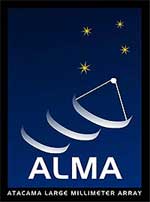
Image credit: ESO
Workers in Chile broke ground today in the construction of the Atacama Large Millimeter Array (ALMA) – a giant radio telescope made up of 64 high-precision radio antennas. ALMA is scheduled to be completed in 2012, but radio astronomers will be able to start using it in 2007, when some of the antennas have been completed. Using interferometry, the radio signals from the individual 12-metre dishes will be combined to act like a single radio telescope 14 kilometres across. Needless to say, it will help astronomers push much deeper into the cosmos when viewing the radio spectrum.
Scientists and dignitaries from Europe, North America and Chile are breaking ground today (Thursday, November 6, 2003) on what will be the world’s largest, most sensitive radio telescope operating at millimeter wavelengths.
ALMA – the “Atacama Large Millimeter Array” – will be a single instrument composed of 64 high-precision antennas located in the II Region of Chile, in the District of San Pedro de Atacama, at the Chajnantor altiplano, 5,000 metres above sea level. ALMA’s primary function will be to observe and image with unprecedented clarity the enigmatic cold regions of the Universe, which are optically dark, yet shine brightly in the millimetre portion of the electromagnetic spectrum.
The Atacama Large Millimeter Array (ALMA) is an international astronomy facility. ALMA is an equal partnership between Europe and North America, in cooperation with the Republic of Chile, and is funded in North America by the U.S. National Science Foundation (NSF) in cooperation with the National Research Council of Canada (NRC), and in Europe by the European Southern Observatory (ESO) and Spain. ALMA construction and operations are led on behalf of North America by the National Radio Astronomy Observatory (NRAO), which is managed by Associated Universities, Inc. (AUI), and on behalf of Europe by ESO.
“ALMA will be a giant leap forward for our studies of this relatively little explored spectral window towards the Universe”, said Dr. Catherine Cesarsky, Director General of ESO. “With ESO leading the European part of this ambitious and forward-looking project, the impact of ALMA will be felt in wide circles on our continent. Together with our partners in North America and Chile, we are all looking forward to the truly outstanding opportunities that will be offered by ALMA, also to young scientists and engineers”.
“The U.S. National Science Foundation joins today with our North American partner, Canada, and with the European Southern Observatory, Spain, and Chile to prepare for a spectacular new instrument,” stated Dr. Rita Colwell, director of the U.S. National Science Foundation. “ALMA will expand our vision of the Universe with “eyes” that pierce the shrouded mantles of space through which light cannot penetrate.”
On the occasion of this groundbreaking, the ALMA logo was unveiled.
Science with ALMA
ALMA will capture millimetre and sub-millimetre radiation from space and produce images and spectra of celestial objects as they appear at these wavelengths. This particular portion of the electromagnetic spectrum, which is less energetic than visible and infrared light, yet more energetic than most radio waves, holds the key to understanding a great variety of fundamental processes, e.g., planet and star formation and the formation and evolution of galaxies and galaxy clusters in the early Universe. The possibility to detect emission from organic and other molecules in space is of particularly high interest.
The millimetre and sub-millimetre radiation that ALMA will study is able to penetrate the vast clouds of dust and gas that populate interstellar (and intergalactic) space, revealing previously hidden details about astronomical objects. This radiation, however, is blocked by atmospheric moisture (water molecules) in the Earth’s atmosphere. To conduct research with ALMA in this critical portion of the spectrum, astronomers thus need an exceptional observation site that is very dry, and at a very high altitude where the atmosphere above is thinner. Extensive tests showed that the sky above the high-altitude Chajnantor plain in the Atacama Desert has the unsurpassed clarity and stability needed to perform efficient observations with ALMA.
ALMA operation
ALMA will be the highest-altitude, full-time ground-based observatory in the world, at some 250 metres higher than the peak of Mont Blanc, Europe’s tallest mountain.
Work at this altitude is difficult. To help ensure the safety of the scientists and engineers at ALMA, operations will be conducted from the Operations Support Facility (ALMA OSF), a compound located at a more comfortable altitude of 2,900 metres, between the cities of Toconao and San Pedro de Atacama.
Phase 1 of the ALMA Project, which included the design and development, was completed in 2002. The beginning of Phase 2 happened on February 25, 2003, when the European Southern Observatory (ESO) and the US National Science Foundation (NSF) signed a historic agreement to construct and operate ALMA, cf. ESO PR 04/03.
Construction will continue until 2012; however, initial scientific observations are planned already from 2007, with a partial array of the first antennas. ALMA’s operation will progressively increase until 2012 with the installation of the remaining antennas. The entire project will cost approximately 600 million Euros.
Earlier this year, the ALMA Board selected Professor Massimo Tarenghi, formerly manager of ESO’s VLT Project, to become ALMA Director. He is confident that he and his team will succeed: “We may have a lot of hard work in front of us”, he said, “but all of us in the team are excited about this unique project. We are ready to work for the international astronomical community and to provide them in due time with an outstanding instrument allowing trailblazing research projects in many different fields of modern astrophysics”.
How ALMA will work
ALMA will be composed of 64 high-precision antennas, each 12 metres in diameter. The ALMA antennas can be repositioned, allowing the telescope to function much like the zoom lens on a camera. At its largest, ALMA will be 14 kilometers across. This will allow the telescope to observe fine-scale details of astronomical objects. At its smallest configuration, approximately 150 meters across, ALMA will be able to study the large-scale structures of these same objects.
ALMA will function as an interferometer (according to the same basic principle as the VLT Interferometer (VLTI) at Paranal). This means that it will combine the signals from all its antennas (one pair of antennas at a time) to simulate a telescope the size of the distance between the antennas.
With 64 antennas, ALMA will generate 2016 individual antenna pairs (“baselines”) during the observations. To handle this enormous amount of data, ALMA will rely on a very powerful, specialized computer (a “correlator”), which will perform 16,000 million million (1.6 x 1016) operations per second.
Currently, two prototype ALMA antennas are undergoing rigorous testing at the NRAO’s Very Large Array site, near Socorro, New Mexico, USA.
International collaboration
For this ambitious project, ALMA has become a joint effort among many nations and scientific institutions. In Europe, ESO leads on behalf of its ten member countries (Belgium, Denmark, France, Germany, Italy, The Netherlands, Portugal, Sweden, Switzerland and the United Kingdom) and Spain. Japan may join in 2004, bringing enhancements to the project. Given the participation of North America, this will be the first truly global project of ground-based astronomy, an essential development in view of the increasing technological sophistication and the high costs of front-line astronomy installations.
The first submillimeter telescope in the southern hemisphere was the 15-m Swedish-ESO Submillimetre Telescope (SEST) which was installed at the ESO La Silla Observatory in 1987. It has since been used extensively by astronomers, mostly from ESO’s member states. SEST has now been decommissioned and a new submillimetre telescope, APEX, is about to commence operations at Chajnantor. APEX, which is a joint project between ESO, the Max Planck Institute for Radio Astronomy in Bonn (Germany), and the Onsala Space Observatory (Sweden), is an antenna comparable to the ALMA antennas.
Original Source: ESO News Release
Hubble Looks at Erupting Star’s Neighborhood
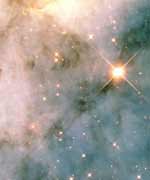
Image credit: Hubble
The newest image released from the Hubble Space Telescope shows a turbulent region of space surrounding an ultra-luminous star called Eta Carinae. The strand-like nature of the nebula was caused by a series of stars that blew off their outer shells – some of the brighter areas in the nebula may eventually turn into new star systems. This picture is only a three light-year chunk of the whole Carina Nebula, which is 200 light-years across and visible to the naked eye in the southern sky.
A small portion of the rough-and-tumble neighborhood of swirling dust and gas near one of the most massive and eruptive stars in our galaxy is seen in this NASA Hubble Space Telescope image. This close-up view shows only a three light-year-wide portion of the entire Carina Nebula, which has a diameter of over 200 light-years. Located 8,000 light-years from Earth, the nebula can be seen in the southern sky with the naked eye.
Dramatic dark dust knots and complex structures are sculpted by the high-velocity stellar winds and high-energy radiation from the ultra-luminous variable star called Eta Carinae, or Eta Car (located outside the picture). This image shows a region in the Carina Nebula between two large clusters of some of the most massive and hottest known stars.
The filamentary structure is caused by turbulence in the circumstellar gas, which in turn was caused by several stars shedding their outer layers. Cold gas mixes with hot gas, leaving a veil of denser, opaque material in the foreground. The chemical elements in the surroundings create a potential reservoir for new star formation. Areas in the brightest parts of the image at the top show elephant-trunk shaped dust clouds that may form into embryonic solar systems.
This Hubble image was taken in July 2002 as part of a parallel observing program. The Hubble telescope has several instruments that can be simultaneously used to look at slightly different portions of the sky. In this case, the Space Telescope Imaging Spectrograph was used to study Eta Carinae itself, while the Wide Field Planetary Camera 2 was used to take this image of the nebulosity near Eta Car. This parallel observing mode increases Hubble’s efficiency and allows astronomers to probe parts of the sky that they would not otherwise be able to investigate.
Produced by the Hubble Heritage team, this color image is a composite of ultraviolet, visible, and infrared filters that have been assigned the colors blue, green, and red, respectively.
Original Source: Hubble News Release
Mapping the Hidden Dark Matter
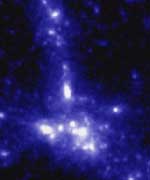
Image credit: Berkeley
Dark matter is an invisible halo of material that seems to surround every galaxy. Astronomers can’t see it, but they know it’s there by the effect of its gravity; there seems to be 10 times as much dark matter as regular matter. Until now, astronomers believed that dark matter probably formed an even mist of particles in space, but researchers from UC Berkeley and MIT have created a computer simulation of how dark matter might clump together into larger chunks of material.
The “dark matter” that comprises a still-undetected one-quarter of the universe is not a uniform cosmic fog, says a University of California, Berkeley, astrophysicist, but instead forms dense clumps that move about like dust motes dancing in a shaft of light.
In a paper submitted this week to Physical Review D, Chung-Pei Ma, an associate professor of astronomy at UC Berkeley, and Edmund Bertschinger of the Massachusetts Institute of Technology (MIT), prove that the motion of dark matter clumps can be modeled in a way similar to the Brownian motion of air-borne dust or pollen.
Their findings should provide astrophysicists with a new way to calculate the evolution of this ghost universe of dark matter and reconcile it with the observable universe, Ma said.
Dark matter has been a nagging problem for astronomy for more than 30 years. Stars within galaxies and galaxies within clusters move in a way that indicates there is more matter there than we can see. This unseen matter seems to be in a spherical halo that extends probably 10 times farther than the visible stellar halo around galaxies. Early proposals that the invisible matter is comprised of burnt-out stars or heavy neutrinos have not panned out, and the current favorite candidates are exotic particles variously called neutrilinos, axions or other hypothetical supersymmetric particles. Because these exotic particles interact with ordinary matter through gravity only, not via electromagnetic waves, they emit no light.
“We’re only seeing half of all particles,” Ma said. “They’re too heavy to produce now in accelerators, so half of the world we don’t know about.”
The picture only got worse four years ago when “dark energy” was found to be even more prevalent than dark matter. The cosmic account now pegs dark energy at about 69 percent of the universe, exotic dark matter at 27 percent, mundane dark matter – dim, unseen stars – at 3 percent, and what we actually see at a mere 1 percent.
Based on computer models of how dark matter would move under the force of gravity, Ma said that dark matter is not a uniform mist enveloping clusters of galaxies. Instead, dark matter forms smaller clumps that look superficially like the galaxies and globular clusters we see in our luminous universe. The dark matter has a dynamic life independent of luminous matter, she said.
“The cosmic microwave background shows the early effects of dark matter clumping, and these clumps grow under gravitational attraction,” she said. “But each of these clumps, the halo around galaxy clusters, was thought to be smooth. People were intrigued to find that high-resolution simulations show they are not smooth, but instead have intricate substructures. The dark world has a dynamic life of its own.”
Ma, Bertschinger and UC Berkeley graduate student Michael Boylan-Kolchin performed some of these simulations themselves. Several other groups over the past two years have also showed similar clumping.
The ghost universe of dark matter is a template for the visible universe, she said. Dark matter is 25 times more abundant than mere visible matter, so visible matter should cluster wherever dark matter clusters.
Therein lies the problem, Ma said. Computer simulations of the evolution of dark matter predict far more clumps of dark matter in a region than there are clumps of luminous matter we can see. If luminous matter follows dark matter, there should be nearly equivalent numbers of each.
“Our galaxy, the Milky Way, has about a dozen satellites, but in simulations we see thousands of satellites of dark matter,” she said. “Dark matter in the Milky Way is a dynamic, lively environment in which thousands of smaller satellites of dark matter clumps are swarming around a big parent dark matter halo, constantly interacting and disturbing each other.”
In addition, astrophysicists modeling the motion of dark matter were puzzled to see that each clump had a density that peaked in the center and fell off toward the edges in the exact same way, independent of its size. This universal density profile, however, appears to be in conflict with observations of some dwarf galaxies made by Ma’s colleague, UC Berkeley professor of astronomy Leo Blitz, and his research group, among others.
Ma hopes that a new way of looking at the motion of dark matter will resolve these problems and square theory with observation. In her Physical Review article, discussed at a meeting earlier this year of the American Physical Society, she proved that the motion of dark matter can be modeled much like the Brownian motion that botanist Robert Brown described in 1828 and Albert Einstein explained in a seminal 1905 paper that helped garner him the 1921 Nobel Prize in Physics.
Brownian motion was first described as the zigzag path traveled by a grain of pollen floating in water, pushed about by water molecules colliding with it. The phenomenon refers equally to the motion of dust in air and dense clumps of dark matter in the dark matter universe, said Ma.
This insight “let’s us use a different language, a different point of view than the standard view,” to investigate the movement and evolution of dark matter, she said.
Other astronomers, such as UC Berkeley emeritus professor of astronomy Ivan King, have used the theory of Brownian motion to model the movement of hundreds of thousands of stars within star clusters, but this, Ma said, “is the first time it has been applied rigorously to large cosmological scales. The idea is that we don’t care exactly where the clumps are, but rather, how clumps behave statistically in the system, how they scatter gravitationally.”
Ma noted that the Brownian motion of clumps is governed by an equation, the Fokker-Planck equation, that is used to model many stochastic or random processes, including the stock market. Ma and collaborators are currently working on solving this equation for cosmological dark matter.
“It is surprising and delightful that the evolution of dark matter, the evolution of clumps, obeys a simple, 90-year-old equation,” she said.
The work was supported by the National Aeronautics and Space Administration.
Original Source: UC Berkeley
Voyager is Nearing the Edge of the Solar System
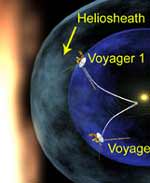
Image credit: NASA
NASA’s Voyager 1 spacecraft has nearly reached the outer limits of the solar system to a region of space, called the heliosheath, where the solar wind blows against interstellar gas. In order to pass into this area; however, Voyager will first pass through a turbulent region called the termination shock. This is the first time scientists have ever gathered data about these distant areas of the solar system. Launched on September 5, 1977, Voyager 1 is now 13 billion km away from the Sun.
NASA’s Voyager 1 spacecraft is about to make history again as the first spacecraft to enter the solar system’s final frontier, a vast expanse where wind from the Sun blows hot against thin gas between the stars: interstellar space. However, before it reaches this region, Voyager 1 must pass through the termination shock, a violent zone that is the source of beams of high-energy particles.
Voyager’s journey through this turbulent zone will give scientists their first direct measurements of our solar system’s unexplored final frontier, called the heliosheath, and scientists are debating if this passage has already begun. Two papers about this research are being published in Nature on November 5, 2003. The first paper, by Dr. Stamatios M. Krimigis of the Johns Hopkins University Applied Physics Laboratory, Laurel, Md., and his team, gives evidence supporting the claim that Voyager 1 passed beyond the termination shock. The second paper, by Dr. Frank B. McDonald of the University of Maryland, College Park, and his team, gives evidence against this claim. A third paper, published October 30, 2003 in Geophysical Research Letters by Dr. Leonard F. Burlaga of NASA’s Goddard Space Flight Center, Greenbelt, Md., and collaborators, gives evidence that Voyager 1 did not pass beyond the termination shock. (Refer to Image 2a for an illustration of the termination shock and heliosheath).
“The Voyager 1 observations show we have entered into a new part of the solar system. Regardless of whether we crossed the termination shock or not, the teams are excited because this has never been seen before – the observations are different here than in the inner solar system,” said Dr. Eric Christian, Discipline Scientist for the Sun Earth Connection research program at NASA Headquarters, Washington, DC.
“Voyager 1 has seen striking signs of the region deep in space where a giant shock wave forms as the wind from the Sun abruptly slows and presses outward against the interstellar wind. The observations surprised and puzzled us, so there is much to be discovered as Voyager begins exploring this new region at the outer edge of the solar system,” said Dr. Edward Stone, Voyager Project Scientist, California Institute of Technology, Pasadena, Calif.
At more than eight billion miles (13 billion km) from the Sun, Voyager 1 is the most distant object built by humanity. Launched on September 5, 1977, it explored the giant planets Jupiter and Saturn before being tossed out toward deep space by Saturn’s gravity. It now approaches, and may have temporarily entered, the region beyond termination shock.
The termination shock is where the solar wind, a thin stream of electrically charged gas blown constantly from the Sun, is slowed by pressure from gas between the stars. At the termination shock, the solar wind slows abruptly from its average speed of 300 – 700 km per second (700,000 – 1,500,000 mph). (Refer to Movie 4 to see how this heats the solar wind in the heliosheath).
The exact location of the termination shock is unknown, and it originally was thought to be closer to the Sun than Voyager 1 currently is. As Voyager 1 cruised ever farther from the Sun, it confirmed that all the planets were inside an immense bubble blown by the solar wind, and the termination shock was much more distant (Animation 1).
Estimating the location of the termination shock is hard because we don’t know the precise conditions in interstellar space, and even what we do know, the speed and pressure of the solar wind, changes which causes the termination shock to expand, contract, and ripple. You can see a similar effect every time you wash dishes (Movie 3). If you place a plate underneath a stream of water, you notice the water spreads out over the plate in a relatively smooth flow. The water flow has a rough edge where the water slows down abruptly and piles up. The edge is like the termination shock, and as the water flow changes, the shape and size of the rough edge change.
From about August 1, 2002 to February 5, 2003, scientists noticed unusual readings from the two energetic particle instruments on Voyager 1, indicating it had entered a region of the solar system unlike any encountered before. This led some to claim that Voyager may have entered a transitory feature of the termination shock. Just as small bumps and “fingers” appear and disappear in the rough edge of the water flow over a plate, Voyager might have entered a temporary “finger” in the edge of the termination shock.
The controversy would be resolved easily if Voyager could still measure the speed of the solar wind, because the solar wind slows abruptly at the termination shock. However, the instrument that measures solar wind speed no longer functions on the venerable spacecraft, so scientists must use data from the instruments that are still working to infer if Voyager pierced the termination shock.
Evidence for crossing the shock includes Voyager’s observation that high-velocity electrically-charged particles (electrons and ions) increased more than 100 times during the August 1, 2002 to February 5, 2003 period. This would be expected if Voyager passed the termination shock, because the shock naturally accelerates electrically charged particles that bounce back and forth like ping pong balls between the fast and slow winds on the opposite sides of the shock.
Secondly, the particles were flowing outward, past Voyager and away from the Sun. This would be expected if Voyager already crossed beyond the termination shock, because the acceleration region in the termination shock would now be behind the spacecraft. Third, an indirect measure of the solar wind speed indicated the solar wind was slow during this period, as would be expected if Voyager was beyond the shock.
“We have used an indirect technique to show that the solar wind slowed down from about 700,000 mph to much less than 100,000 mph. This same technique was used by us before, when the instrument measuring the solar wind speed was still working, and the agreement between the two measurements was better than 20% in most cases,” said Krimigis.
Evidence against entry into the shock includes the observation that while there was a dramatic increase in low-speed particles, they weren’t seen at the somewhat higher speeds scientists believe the termination shock generates.
However, the strongest evidence against entry is Voyager’s observation that the magnetic field did not increase during this period. According to theoretical models, this must happen whenever the solar wind slows down. Imagine a highway with moderate traffic. If something makes the drivers slow down, say a puddle of water, the cars pile up – their density increases. In the same way, the density (intensity) of the magnetic field carried by the solar wind will increase if the solar wind slows down.
“The analysis of the Voyager 1 magnetic field observations in late 2002 indicate that it did not enter a new region of the distant heliosphere by having crossed the termination shock. Rather, the magnetic field data had the characteristics to be expected based upon many years of previous observations, although the intensity of energetic particles observed is unusually high,” said Burlaga.
The teams agree that Voyager 1 has seen a new phenomenon: a six-month period when low-energy particles were very abundant and flowing away from the Sun. When the unusual period ended, both agree that Voyager 1 was back in the solar wind, so if this was a temporary passage beyond the termination shock, the shock will be seen again, probably in the next couple years. Finally, the observations indicate that the termination shock is a lot more complicated than anyone thought.
For their original missions to Jupiter and Saturn, Voyager 1 and sister spacecraft Voyager 2 were destined to regions of space where solar panels would not be feasible, so each was equipped with three radioisotope thermoelectric generators to produce electrical power for the spacecraft systems and instruments. Still operating in remote, cold and dark conditions 26 years later, the Voyagers owe their longevity to these Department of Energy-provided generators, which produce electricity from the heat generated by the natural decay of plutonium dioxide.
The Voyagers were built by NASA’s Jet Propulsion Laboratory (JPL) in Pasadena, Calif., which continues to operate both spacecraft 26 years after their launch. The spacecraft are controlled and their data returned through NASA’s Deep Space Network (DSN), a global spacecraft tracking system also operated by JPL. The Voyager Project Manager is Ed Massey of JPL. The Voyager Project Scientist is Dr. Edward Stone of the California Institute of Technology.
Original Source: NASA News Release
Leonid Meteors on November 17
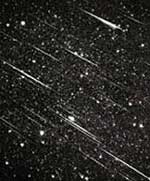
Image credit: NASA
The Leonid meteor shower will be making an appearance on November 17, 2003, and it might be an impressive show. These meteors are the minute dust trails of Comet 55P/Tempel-Tuttle which flash in the sky as they strike the Earth’s atmosphere. In past years, the Leonids have been very impressive, sometimes thousands of meteors have been seen. Astronomers aren’t sure how many will strike the Earth this year – it could be anywhere from a couple an hour to several hundred per hour. The best views will be in Europe, but the rest of the world will still get a show if they watch the skies after midnight.
It’s back! After exceptional displays in recent years, the Leonid meteor shower will appear under dark skies November 17, 2003. Although no one knows for sure what the shower has in store for us, estimates range from a few meteors up to hundreds of meteors per hour at the peak.
Predicting meteor rates, particularly for the highly variable Leonid shower, is akin to estimating the number of snowflakes that will fall on an area of ground. You simply can’t know until it’s all over. And in the case of the Leonids, only observers outside will find out what happens.
The remarkable activity seen during the past few years came about because Earth crossed through regions that the shower’s parent comet, 55P/Tempel-Tuttle, had visited. This year, the timing of Earth’s passage across the comet’s orbit favors observers in Europe. They should see the shower’s peak before dawn on November 18. For North America, the peak arrives the previous evening, although the best views still should come after midnight. Light from the Last Quarter Moon interferes somewhat, but the brighter Leonids should shine through nicely.
Mythology and finding Leo
The Leonids are named after the constellation Leo the Lion. If you trace all the meteor trails backward, they would meet within the boundaries of that constellation. In Greek and Roman mythology, Leo represents the Nemean Lion, whose slaying was the first of Hercules’s twelve labors. To find Leo in the sky, first locate the Big Dipper in the northeast. Poke a hole in the bottom of the Big Dipper’s bowl. As the water runs out, you may hear a mighty roar as the water falls on the back of Leo. In 2003, Leo is even easier to locate. Simply look for the Moon in the early morning hours of November 18, when the Last Quarter Moon will be in the center of the constellation. Adding to the spectacle, the planet Jupiter will be shining brilliantly just to the lower left of the Moon. Jupiter will appear as the brightest starlike object in the sky.
What are meteors?
Meteors are small particles of rock and metal that Earth encounters (runs into) during its orbit around the Sun. In space, these particles are called meteoroids. When they burn up in Earth’s atmosphere, we observe bright streaks called meteors. If they survive the fiery passage through our thick blanket of air and land on Earth, they are called meteorites. No meteorites are generated from meteor showers – the particles are too small.
All meteor showers are caused by comets. As a comet swings around the Sun, heat from the Sun vaporizes the ice in the comet, releasing small particles (meteoroids). Sometimes the orbit of this debris crosses Earth’s orbit. When our planet runs into this stream of particles, we experience a meteor shower.
The Leonid meteor shower is caused by comet 55P/Tempel-Tuttle. This comet was discovered in 1865 by Ernst Tempel and in 1866 by Horace Tuttle. The comet itself is about 2.5 miles (4 kilometers) in diameter and orbits the Sun during a period of slightly more than 33 years. When it makes its closest approach to the Sun, the comet also passes close to Earth’s orbit. This last happened on February 28, 1998. The encounter with the debris stream from Tempel-Tuttle lasts several days, but the most intense part of the encounter typically lasts only two to three hours.
Leonid meteors are fast (they move at 35 to 40 miles per second), and some leave smoke trails that can last a number of seconds. Many Leonids are also bright. Usually, Leonid meteors are white or bluish-white, but in recent years, some observers reported yellow-pink- and copper-colored meteors.
Observing the event
To see the meteors, you’ll need a clear, dark sky. Dark means at least 40 miles from any large city. No telescope is required. In fact, the naked eye works best. Take a lawn chair, cookies, fruit, and a non-alcoholic beverage. (Alcohol interferes with your eyes’ dark adaptation as well as your visual perception of events.) Most importantly, dress warmly, preferably in layers, because Leonid-watching involves no movement or exercise. You’ll be either sitting or standing, and – because it’s November – you will get cold.
Usually, the best advice for meteor-spotters is to go out after midnight during the showers. This is when your part of Earth faces the same direction as the planet’s orbit around the Sun. Earth, therefore, is running into the meteor stream. This year, however, because of the times of the shower’s peak and moonrise, a better plan is to begin observing at dusk on Monday, November 17, and keep watching until the cookies run out.
After sunset, face east and look one-third to one-half of the way up in the sky. Glancing around won’t hurt anything. After moonrise, turn around so you are facing west (away from the Moon) and look overhead.
Photographing meteors
The Leonid meteor shower is not only a wonderful event to observe visually but also a wonderful shower to photograph. On a non-shower night, it’s difficult to photograph meteors because they can occur in any part of the sky. Because meteors move so quickly, they don’t register well on film. With the Leonid shower, however we expect many bright meteors throughout the night.
You will have more success photographing meteors under a dark sky because the background glow will be lowest. Low background illumination allows you to expose the film for longer intervals of time, increasing the chances of capturing meteors on film. Select a camera that allows you to take time exposures, a cable release to minimize vibrations when you open the shutter, and a tripod to steady your camera. Set the camera’s lens wide open (the smallest f-stop on the lens), and set the focus to infinity. Use fast film – ISO 400 or higher. Whether it’s color or black-and-white film is up to you. Expose each frame for ten to twenty minutes. Good luck!
For the most up-to-date astronomy information and beautiful astronomical images, be sure to check out Astronomy magazine and Astronomy.com.
Original Source: Astronomy Magazine News Release
Mars Rover Should Work Fine
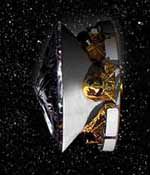
Image credit: NASA/JPL
NASA engineers have been working through a problem with one of the Mars rovers currently traveling to the Red Planet, and they think they’ve got a solution. Back in August, engineers detected that Spirit’s M?ssbauer spectrometer – a device for identifying iron-bearing rocks – was sending back incorrect readings. They’ve been able to compensate for the readings, so long as Spirit continues to behave on Mars as it’s working right now. The rovers will land on Mars in January 2004.
A series of tests of one of the science instruments on NASA’s Mars Exploration Rover Spirit has enabled engineers and scientists to identify how to work around an apparent problem detected in August.
Tests now indicate that all of the science instruments on both Spirit and its twin, Opportunity, are in suitable condition to provide full capabilities for examining the sites on Mars where they will land in January.
Spirit’s M?ssbauer spectrometer, a tool for identifying the types of iron-bearing minerals in rocks and soil, returned data that did not fit expectations during its first in-flight checkup three months ago. A drive system that rapidly vibrates a gamma-ray source back and forth inside the instrument appeared to show partial restriction in its motion.
“The drive system is adjustable. We can change its velocity. We can change its frequency,” said Dr. Steve Squyres of Cornell University, Ithaca, N.Y., principal investigator for the rovers’ science instruments. “We’ve found a set of parameters that will give us good M?ssbauer science if the instrument behaves on Mars the way it is behaving now.”
The corrective countermeasures include using a higher frequency of back-and-forth motion. “With these settings, whatever happened during launch will not decrease the quality of the data we get from the instrument,” said Dr. G?star Klingelh?fer, of Johannes Gutenberg University, Mainz, Germany, lead scientist for the M?ssbauer spectrometers on both rovers. “The instrument was designed with enough margin in its performance that we can make this change with no significant science impact.”
A possible explanation for the instrument’s behavior since launch is that intense vibration of the spacecraft during launch shook something inside the spectrometer slightly out of position, he said.
Landings on Mars are risky. Most attempts over the years have failed. And even if the spacecraft survives the landing, there is the potential that individual components could be damaged. “One remaining issue with the M?ssbauer Spectrometer on Spirit, as with all the instruments, is that we can’t be one hundred percent sure it?ll operate on Mars the way it?s operating now,” Squyres said. “We?ll breathe easier once we?ve done all our post-landing health checks.”
Another fact that has emerged from the in-flight checkouts of the M?ssbauer spectrometers on both spacecraft is that the internal calibration channel of the M?ssbauer spectrometer on Opportunity is not functioning properly. But because the instrument has the redundancy of a separate, completely independent external calibration method, this problem will not hamper use of that instrument, Squyres said.
Spirit is on course to arrive at Mars’ Gusev Crater at 04:35 Jan. 4, 2004, Universal Time, which is 8:35 p.m. Jan. 3, Pacific Standard Time and 11:35 p.m. Jan. 3, Eastern Standard Time. (These are “Earth received times,” meaning they reflect the delay necessary for a speed-of-light signal from Mars to reach Earth; on Mars, the landing will have happened nearly 10 minutes earlier.) Three weeks later, Opportunity will arrive at a level plain called Meridiani Planum on the opposite side of Mars from Gusev. Each rover will examine its landing area for geological evidence about the history of water there, key information for assessing whether the site ever could have been hospitable to life.
As of 13:00 Universal Time on Nov. 5 (5 a.m. PST; 8 a.m. EST), Spirit will have traveled 367.4 million kilometers (228.3 million miles) since its launch on June 10 and will still have 119.6 million kilometers (74.3 million miles) to go before reaching Mars. Opportunity will have traveled 296 million kilometers (184 million miles) since its launch on July 7 and will still have 160 million kilometers (99.2 million miles) to go to reach Mars.
The Jet Propulsion Laboratory, a division of the California Institute of Technology, manages the Mars Exploration Rover project for NASA’s Office of Space Science, Washington, D.C. Additional information about the project is available from JPL at http://mars.jpl.nasa.gov/mer and from Cornell University, Ithaca, N.Y., at http://athena.cornell.edu.
Original Source: NASA/JPL News Release
NASA Marks the Third Year of People on the Station
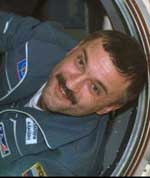
Image credit: NASA
As of Sunday, November 2, the International Space Station has had humans on board for three years. The current crew, Expedition 8, arrived on board only a few weeks ago to replace Expedition 7 who had been on board for six months. With the loss of the space shuttle Columbia earlier this year, construction on the station has come to a halt. 76,000 kg of new equipment is currently being readied for launch, including scientific laboratories and new solar panels.
In a period that has exemplified the benefits of international cooperation in space, the International Space Station will complete a third year of permanent human presence aboard on Sunday, Nov. 2.
The third year of humans living aboard the station has been marked by the perseverance of the orbiting laboratory and international partnership through the tragedy of the Columbia accident.
“Every endeavour that continuously pushes the boundaries of human achievment can have times of both great triumph and great tragedy. The space agencies and nations around the world that are our partners in the Station understand that and they have experienced it,” ISS Program Manager Bill Gerstenmaier said. “The perseverance of crewed operations aboard the Station this year has brought the partnership closer together, and it will strengthen the Station through both the improvements in safety that we plan and the lessons we learn together.”
The eighth resident crew — Commander and NASA ISS Science Officer Mike Foale and Flight Engineer Alexander Kaleri — began a six-month stay aboard the complex Oct. 20.
The station remains the largest, most sophisticated and most powerful spacecraft ever built. Until the Space Shuttle fleet returns to flight, the transport of supplies and crews to the Station will be conducted by Russian spacecraft. The majority of power, cooling, volume and research capacity on the station are supplied by U.S. components. The station has a mass of almost 400,000 pounds and an interior volume roughly equal to that of a three-bedroom house. The U.S. Destiny Laboratory now houses seven different research facilities. The International Space Station partnership includes NASA; Rosaviakosmos, the Russian Space Agency; the Canadian Space Agency; the European Space Agency; and the Japanese Aerospace Exploration Agency.
At the Kennedy Space Center, Fla., 168,000 pounds of additional Station components are being prepared for launch when the Space Shuttle returns to flight. Those components will triple the number of science facilities aboard the orbiting laboratory, increase the total power available for research by over 80 percent and triple the surface area of the Station’s solar arrays. Among components at KSC is the second Station laboratory, the Japanese Experiment Module named Kibo.
Original Source: NASA News Release
